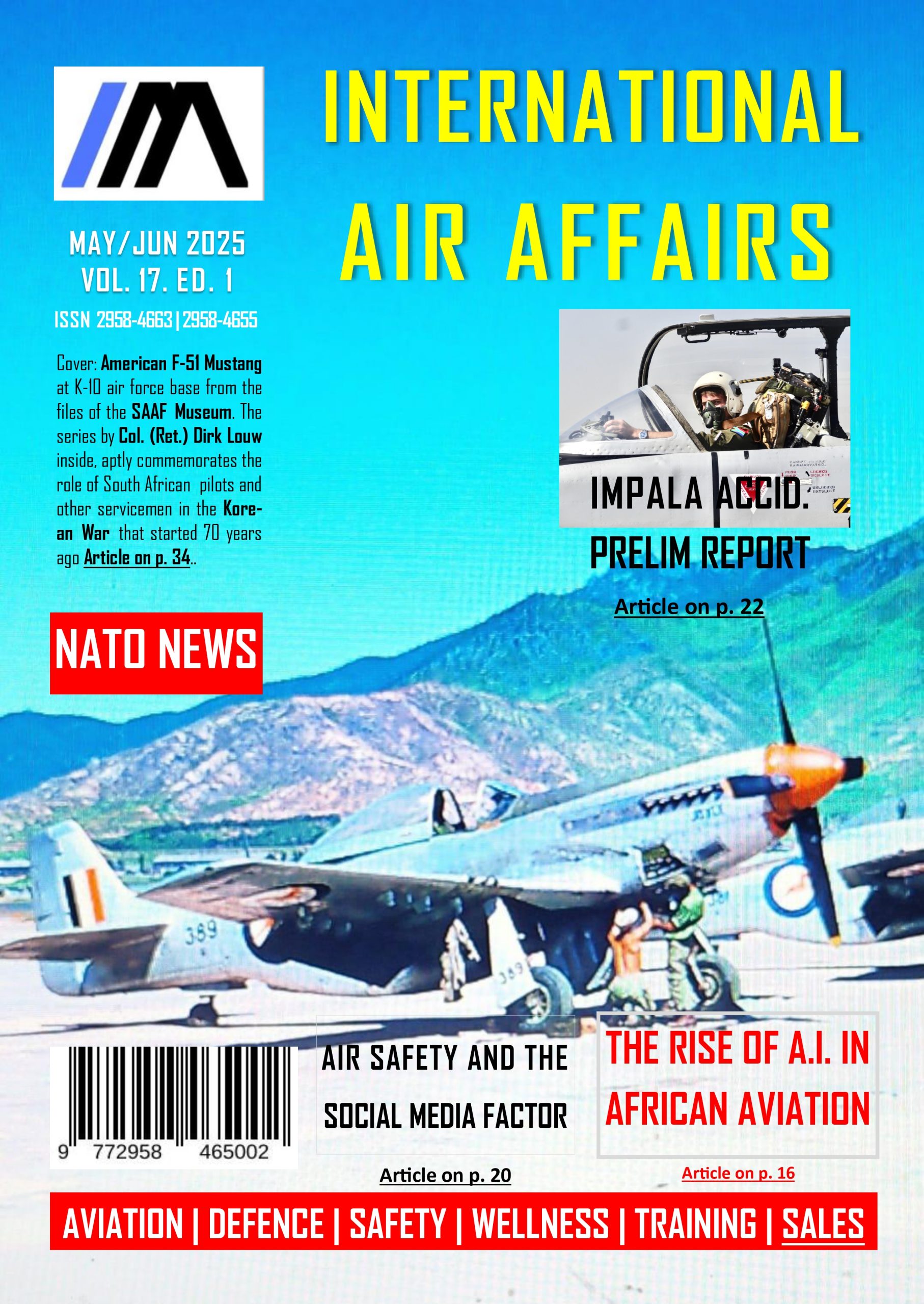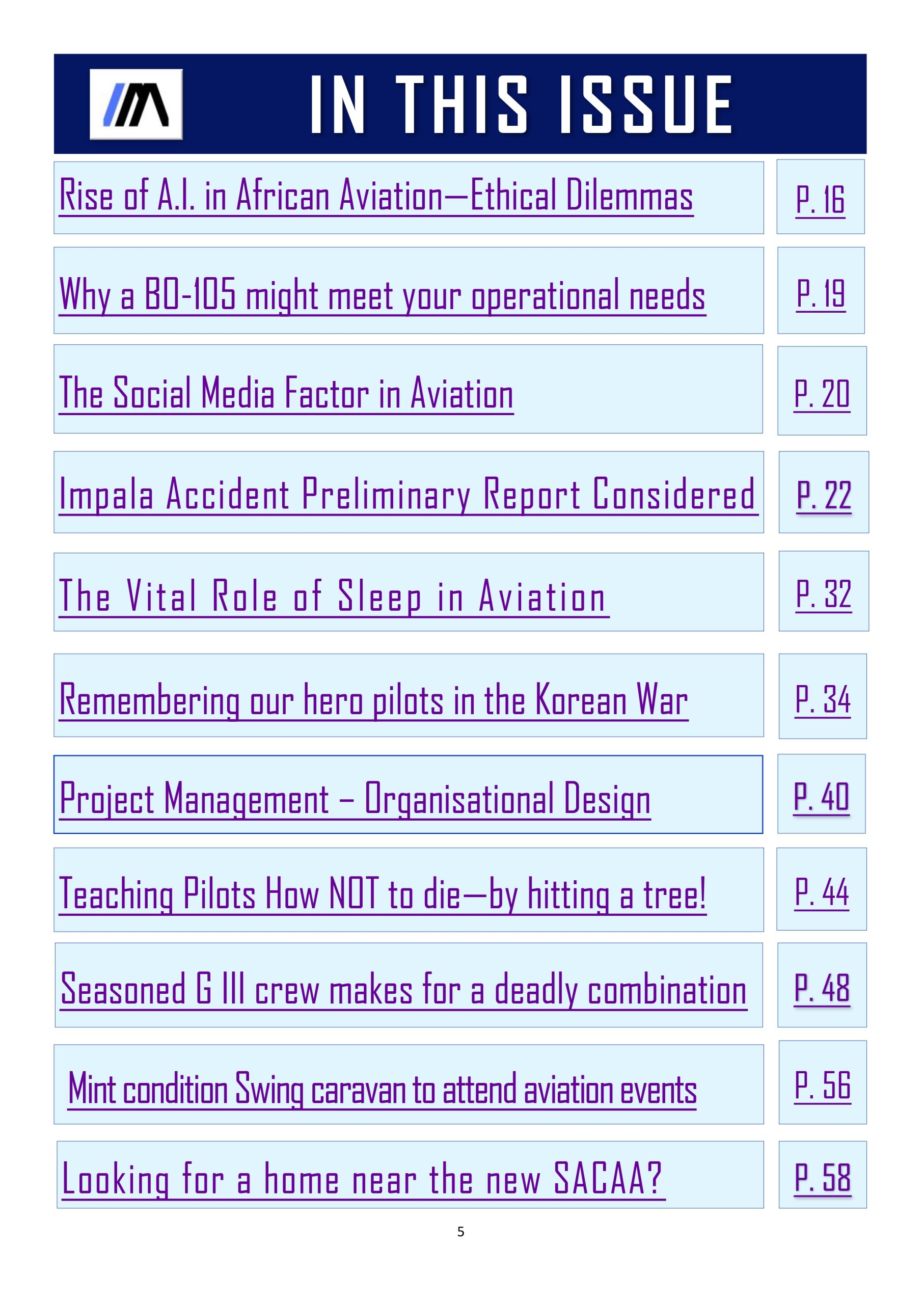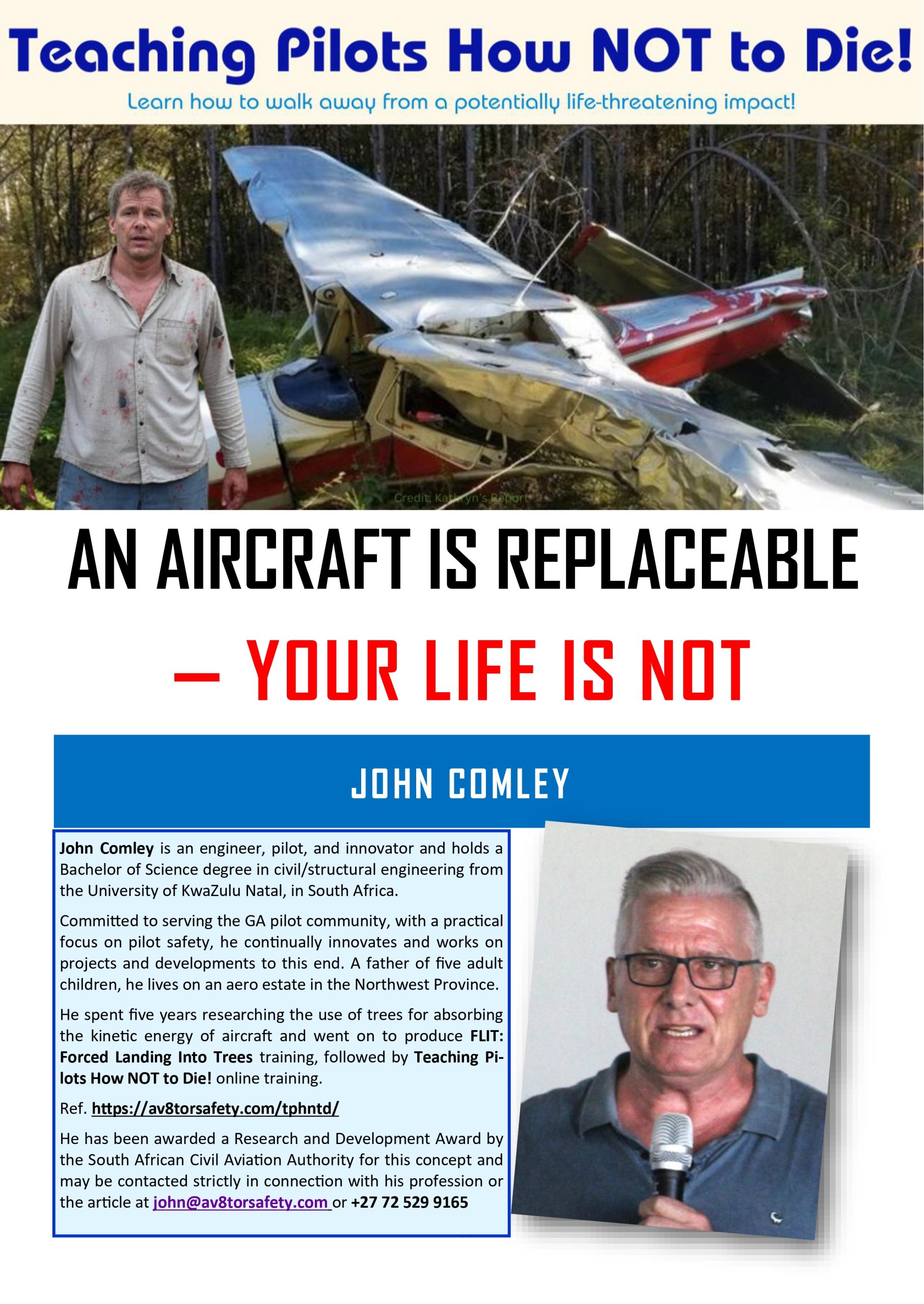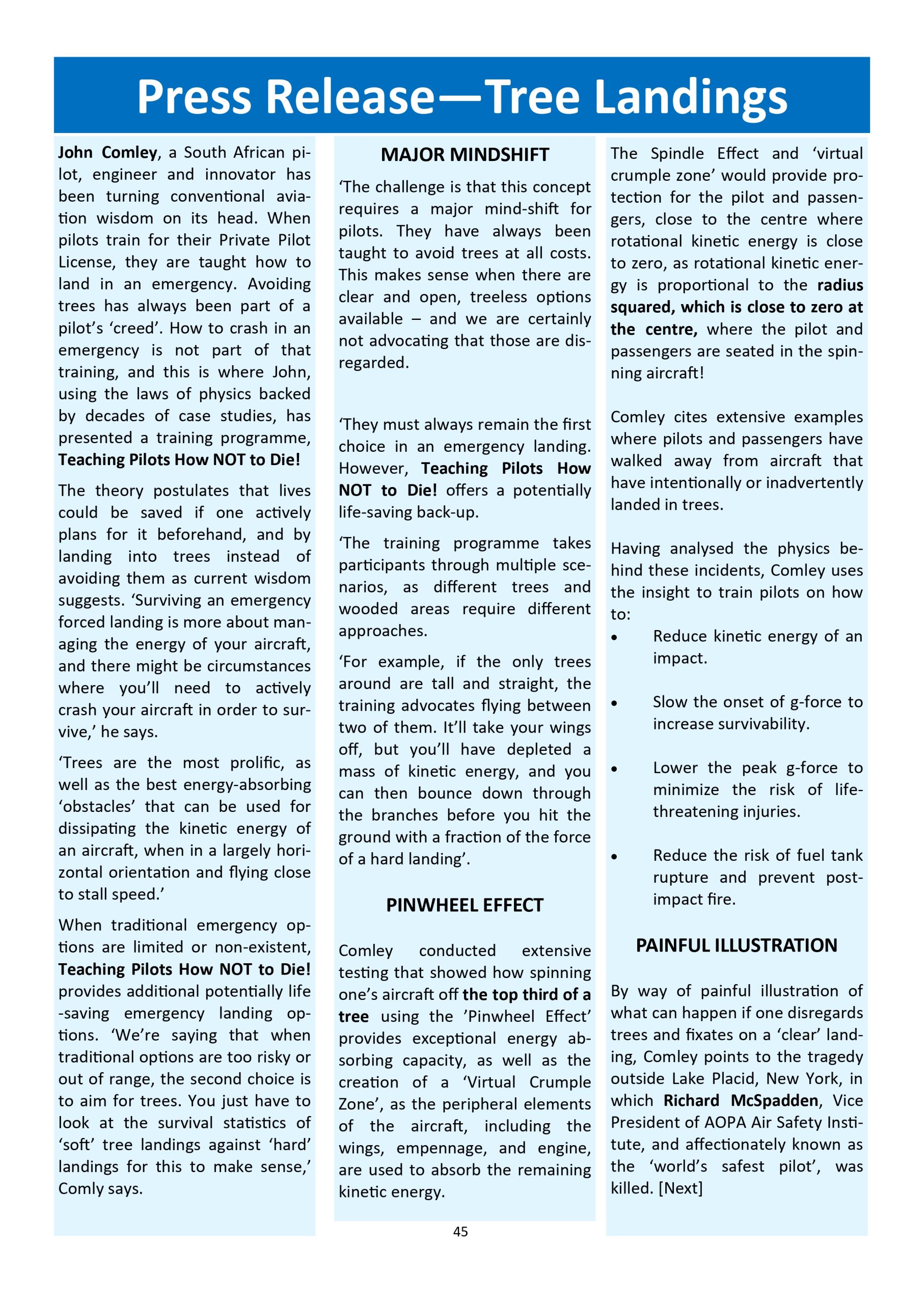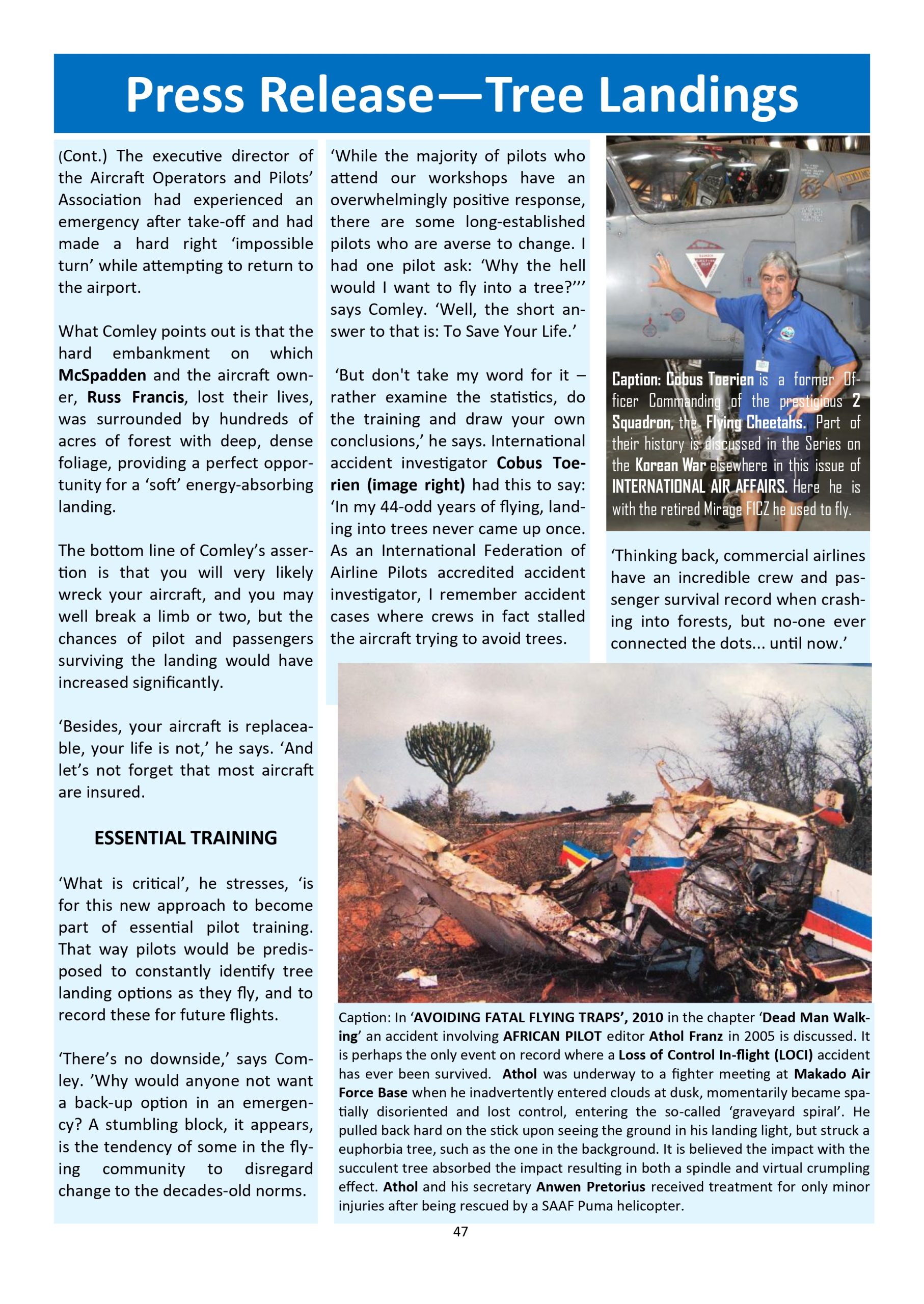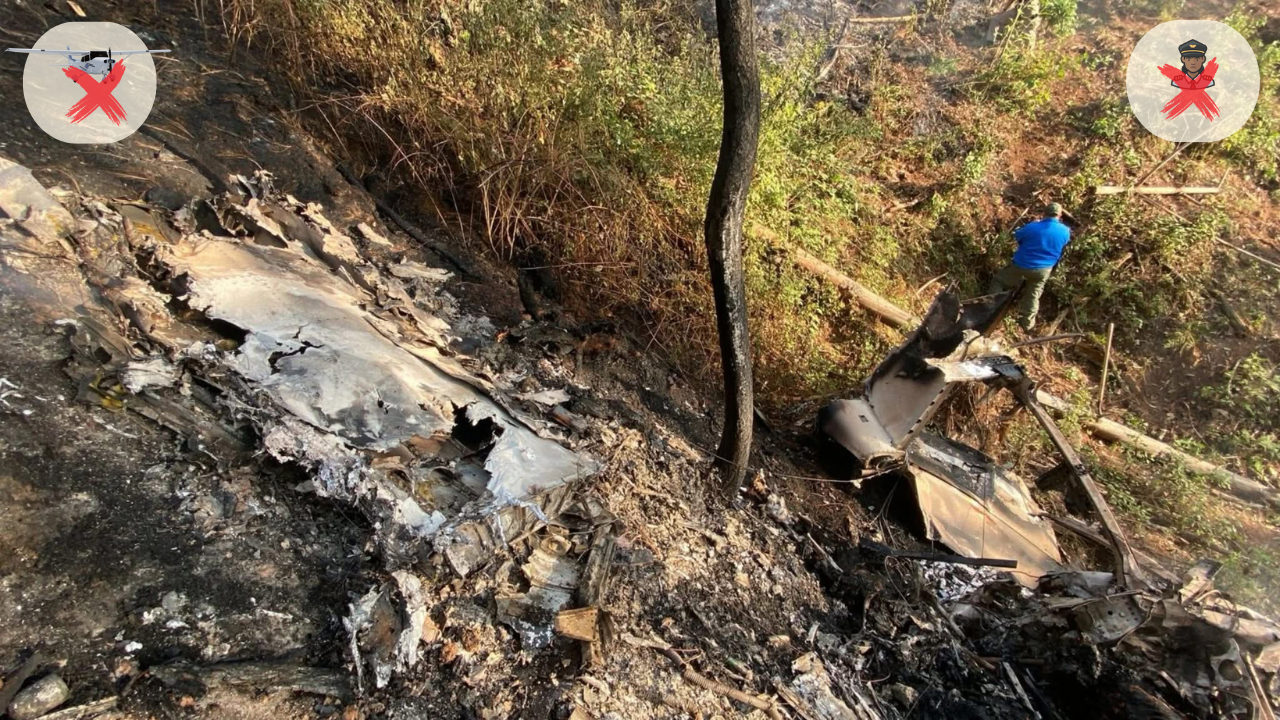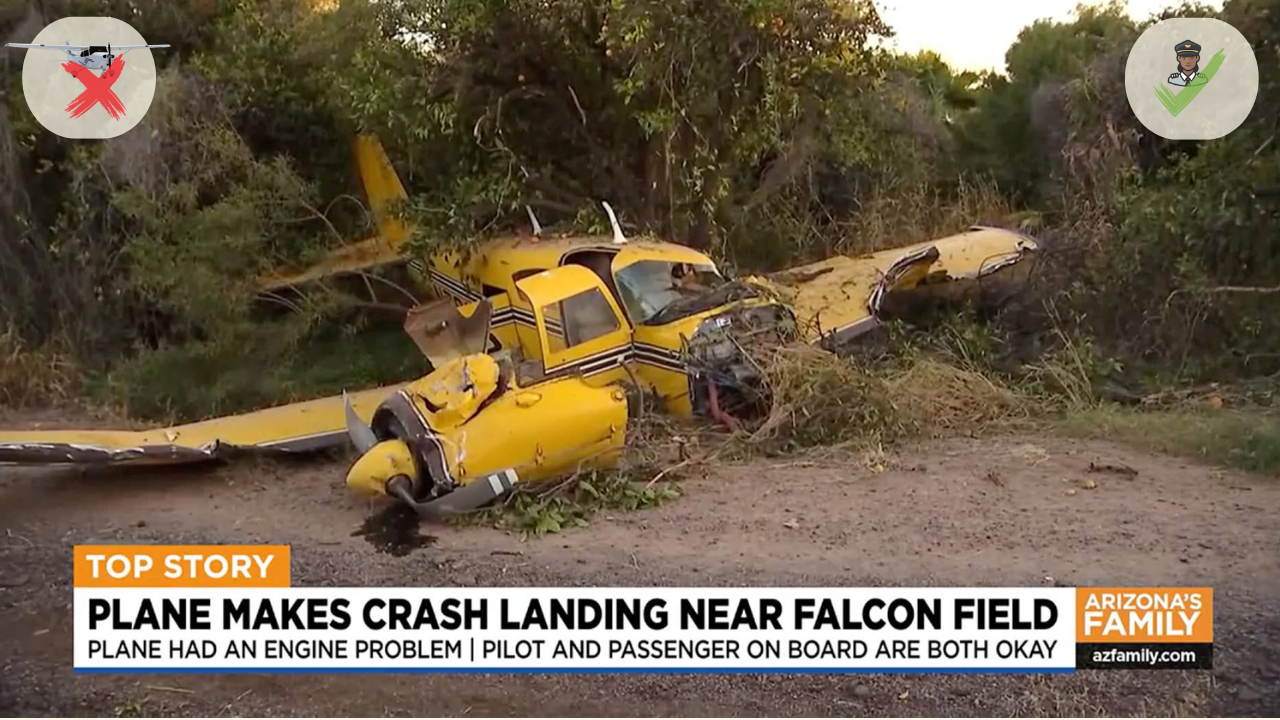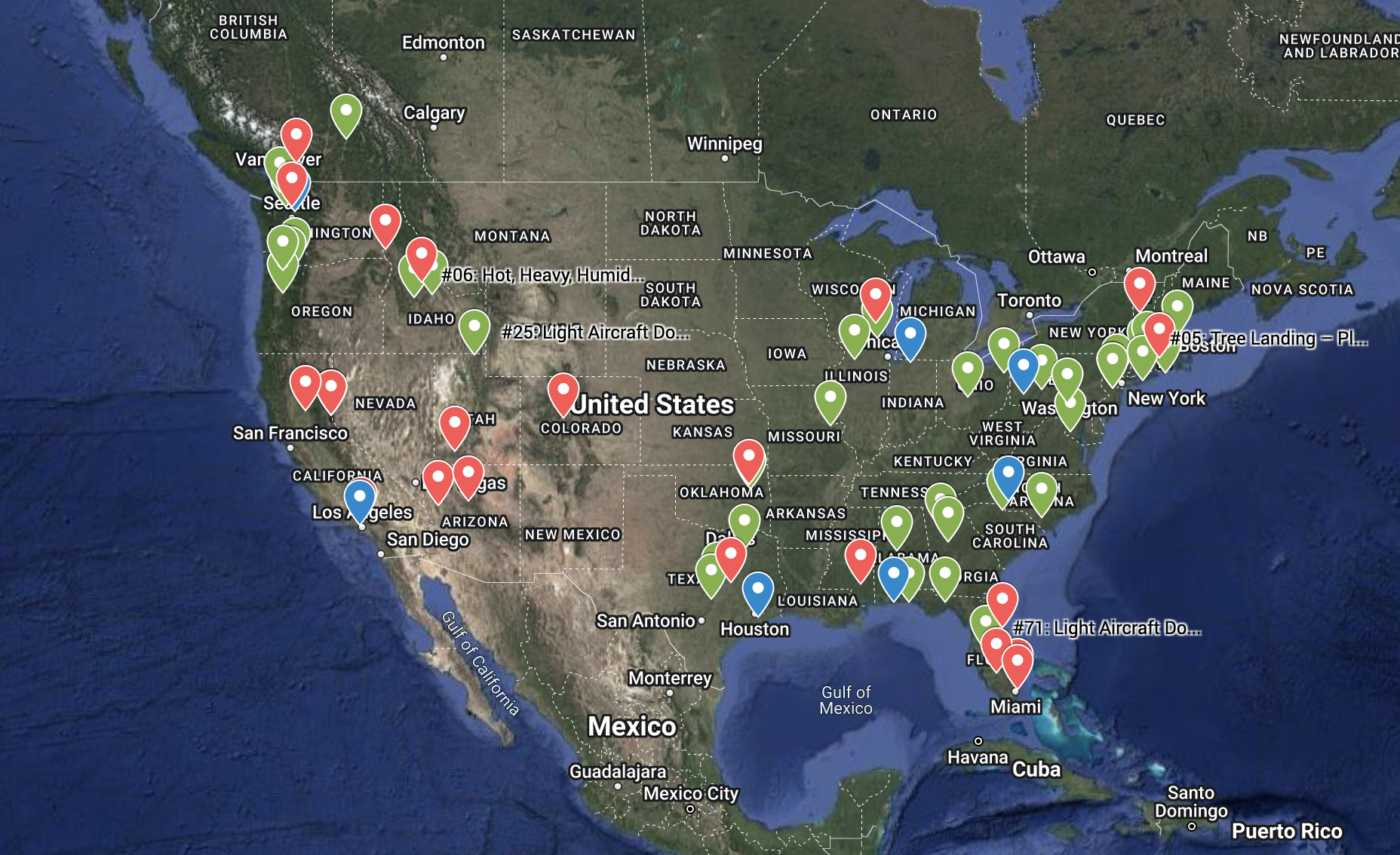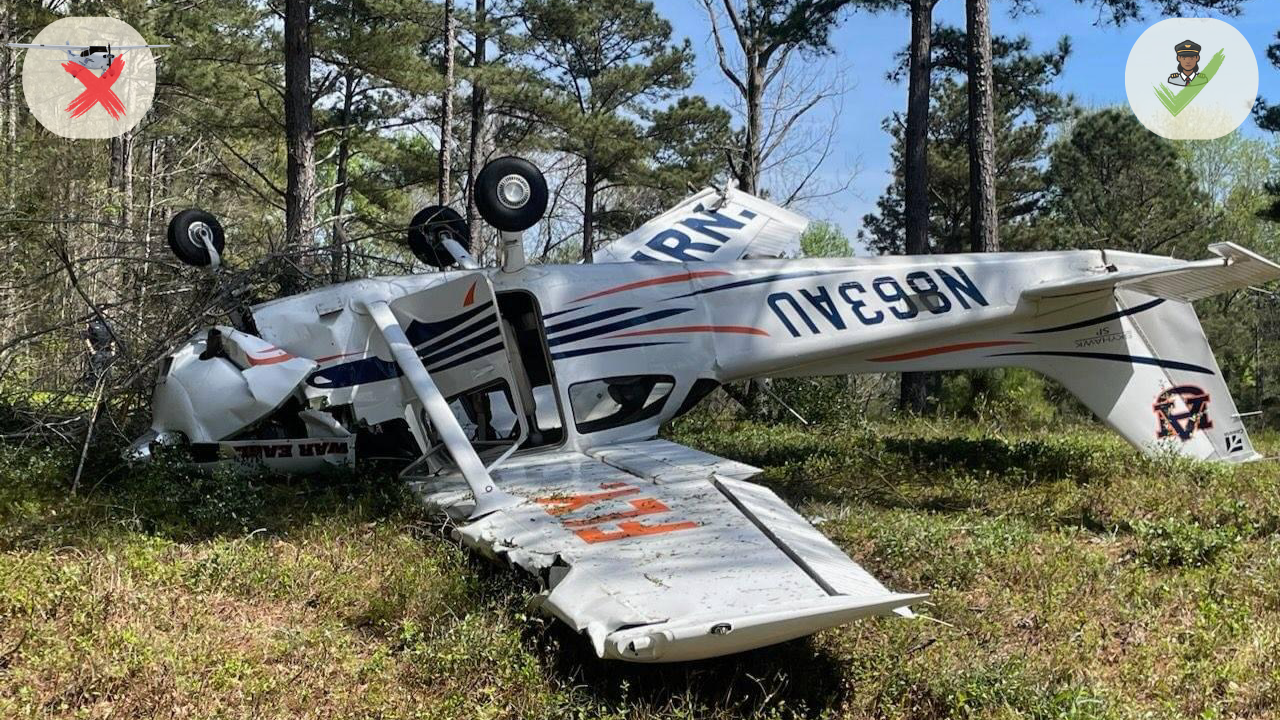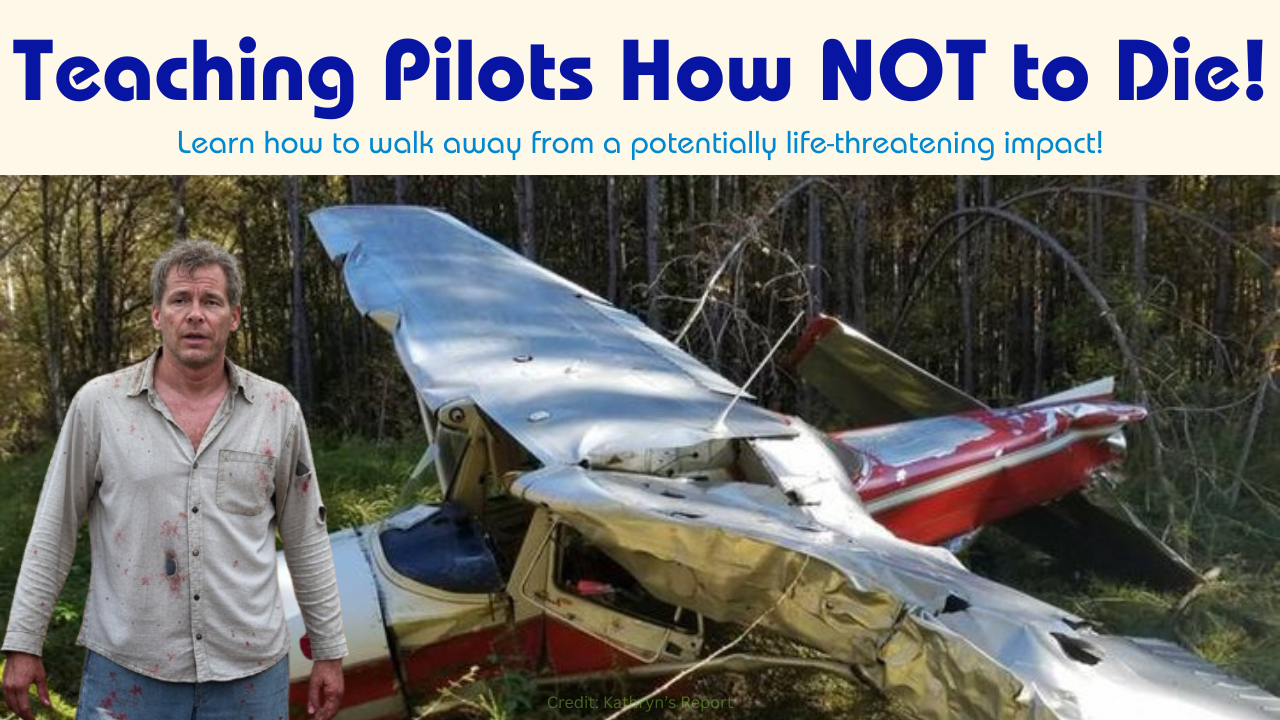
YES! This aircraft crash was survivable! The Teaching Pilots How NOT to Die! training will show you why!
Teaching Pilots How NOT to Die!
Pilot, engineer and award-winning aviation safety expert, John Comley, brings you Teaching Pilots How NOT to Die!, a short MUST-VIEW course on how best to improve your odds of survival in the event of an aircraft accident or an emergency forced landing, particularly when traditional forced landing options are few!
John spent five long years studying the main factors influencing why certain accidents lead to fatalities, whereas why, in other accidents, which were often far worse accidents resulting in more damaged aircraft, the pilots and passengers survived.
The results of this study and the methods of best mitigating fatal accidents has stunned the aviation world.
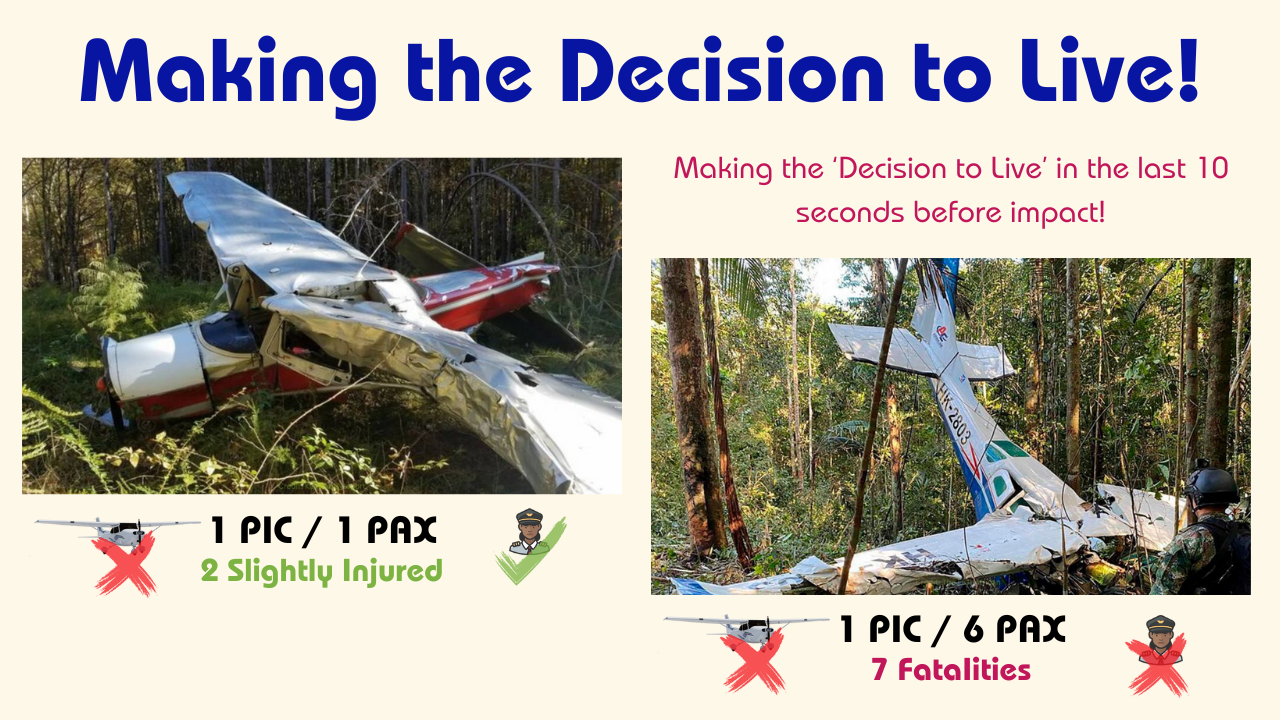
When the chips are down and safe landing options are few or non-existent, learn how to crash your aircraft in a manner that will give you the best option for survival.

Learn how THIS training could have saved the life of the 'World's Safest Pilot' . . .
In one of the key case studies in the Teaching Pilots How NOT to Die! training, you will learn what could have averted a tragedy like this, in which a pilot with the title of ‘The World’s Safest Pilot’ lost his life, along with the life of a close friend.


Pilots hearing what this training has to offer are astounded that it does not form part of the ab initio syllabus.
Flight schools do a good job of teaching pilots how to fly, but very few teach pilots how NOT to die!
“I’ll be honest, when I was first introduced to the Forced Landing Into Trees (FLIT) concept, I was sceptical as to the merits of such doctrine, yet after attending a presentation by John Comley I immediately grasped the value of such actions.
I’ve followed John’s doctrine to his current, Teaching Pilots How Not To Die! (TPHNTD) philosophy which is an evolved and scientifically developed strategy for a pilot to keep him/herself and their passengers alive, following an engine failure, using common sense and available natural resources, which mitigate the deceleration force, which is so often the killer in such instances.
Such strategy needs to be a mindset, to ensure that such process is followed when the engine stops working.
I view the concept as simply brilliant!”

Duncan Gillespie
Commercial & GA Pilot
FlyAfrica Facebook Group
“Rated on 59 GA aircraft including helicopter, plus involvement with flight safety for over 30 years, has not given me the perspective of understanding the value of managing kinetic energy during a forced landing. THIS COURSE IS A MUST FOR ANY RESPONSIBLE PILOT!!”

Johann L.
Pilot of 30 Years
“This course broadened my thinking when It comes to aviation. Not just in engine failure scenarios, but in all flying scenarios am I now considering trees my saviours and friends!”

Donovan J.
GA Pilot
“There is absoluttely no question . . . this is a MUST for any pilot wishing to prioritise their own lives as well as the lives of their passengers.
This training could literally make the difference between life and death when faced with a challenging emergency forced landing.”

Andre v Z.
GA Pilot
“This course gave me a whole new perspective on aviation safety. Understanding how to manage kinetic energy could be the key to survival in an emergency”

John S.
GA Instructor
“I’ve attended many safety briefings, but this course provided practical, actionable techniques that I can apply immediately.”

Pieter V.
GA & Helicopter Pilot
“A must for any pilot who values their life and their passengers’. The insights into mitigating a potentially fatal impact are game-changing.”

Sarah T.
GA Pilot of 22 Years
“This training doesn’t just teach theory—it’s about survival. The focus on using the aircraft to absorb impact is invaluable.”

Michael R.
Commercial Pilot 12 Years
“How can it be that I have been flying for over 20 years, and have never heard about this, let alone be taught about it! WHY? This is ESSENTIAL training for ALL pilots.”

Willem J.
GA & Gyrocopter Pilot
“After completing this course, I feel significantly more prepared to handle an emergency landing scenario.“

Lisa H.
GA Pilot
“Every pilot should take this course. It’s not about flying; it’s about surviving when things go wrong.“

Andrew B.
GA Bush Pilot & Commercial Pilot
“This course equips you with tools that could one day save your life. The emphasis on reducing kinetic energy is eye-opening.“

Nicola S.
GA Pilot 7 Years
“Learning how to use the aircraft itself as part of the survival strategy was revolutionary for me.“

Richard K.
GA Pilot
“An essential course for pilots. It goes beyond the basics and into strategies that can truly make a difference in an emergency.“

Mark D.
GA Pilot 12 Years
“The training on managing impact forces gave me confidence that I could make better decisions in a crisis.“

James W.
GA Pilot
“The real-world examples and techniques shared in this course were practical and easy to understand.“

Daniel H.
GA Pilot
“Aviation safety is about preparation, and this course fills a critical gap in understanding crash survivability.“

Sarah T.
Student Commercial Pilot
“If you’re serious about flying safely, this course should be at the top of your list. It’s about protecting lives.“

Simon M.
GA Fixed Wing & Helicopter Pilot
“As a pilot, I now understand how to better control and manage energy during a forced landing. This training is invaluable.“

Daniel G.
GA Bush Pilot
“It’s rare to find a course that is this practical and life-focused. I’m grateful for the insights it provided.“

Kobus V.
PPL Pilot
“This course taught me techniques that could mean the difference between a survivable landing and a fatal crash.“

Trevor J.
GA Pilot
“I left this course with actionable knowledge and skills that will always stay in the back of my mind while flying.“

Anton B.
Student Pilot (PPL)
“Understanding the physics behind crashes and how to mitigate impact forces should be part of every pilot’s training.“

Ruan O.
Gyrocopter & GA Fixed Wing Pilot
“This is not just another safety course. It’s a wake-up call for every pilot to be prepared for the unexpected.“

Thomas R.
GA Pilot
“I recommend this course to every pilot I know. It’s about more than flying; it’s about surviving when things don’t go as planned.“

Sibusiso M.
PPL Student Pilot
Learn what factors could have helped save the lives of this pilot + 6 passengers!
Source: www.alsresume.com
“When a pilot (and passengers) perishes in an aircraft accident, suddenly – in an instant – they’re gone. They blast a hole in the lives of spouses, children, grandchildren, and close friends that can never be filled by anyone else. The mourners learn to cope with the loss, but they never get over it.”
– Richard McSpadden

The ‘Teaching Pilots How NOT to Die’ is a SHORT course, designed to give pilots the tools needed in less than TWO HOURS of study!
Backed by The Laws of Physics
Everything you will learn about in ‘Teaching Pilots How NOT to Die!’ is backed by millenial-old Laws of Physics, including the Laws of Energy, the Laws of Motion, and the Laws of Forces.
Learn this and apply it, and you will stand a better chance of surviving a potentially fatal aircraft accident.
Understanding Energy in Aviation
The course will explain the main types of energy in aviation, along with how they convert between the energy types right up to the point of impact.
Understanding this is CRITICAL to being able to best manage the forces that are typically associated with an aircraft impact.
Understand the FOUR Elements of G-Force
Most pilots know g-force as a single element, whereas there are FOUR elements to g-force, and understaning them, along with how to control them, can make the difference in surviving when the chips are down!
Learn How to Reduce the Effect of High Kinetic Energy & G-Force
No upgrades needed to your aircraft, just this training in how to reduce the often fatal effects of kinetic energy and g-force.
Knowing what you will learn through this training will greatly increase your chances of surviving an aircraft crash.
Learn How 'Spinning Your Aircraft' can SAVE YOUR LIFE!
This has most pilots scratching their heads, but is one of the most effective ways to reduce high kinetic energy and the resultant g-force when stopping suddenly.
Are TREES an Option for Absorbing Kinetic Energy
Yes, we know . . . pilots have always been taught that trees are obstacles, and that they should be avoided at all costs.
In this training, we show how effective trees are as kinetic energy absorbing obstacles.
Case Study Reviews
A number of gripping case studies will allow you to learn what to do, and, indeed, what NOT to do when faced with an impending aircraft crash.
In particular, the one case study focuses on how the world’s safest piot died, and how, had this training been adopted, the pilot and his co-pilot/passenger may well have survived what ended up as a fatal accident.
The TEN Cardinal Rules for Surviving an Emergency Forced Landing
The ‘Teaching Pilots How NOT to Die!’ course will teach pilots the ‘TEN Cardinal Rules for Surviving an Aircraft Accident’!
Be able to tick these TEN BOXES when under the pressure of an emergency forced landing, and your chances of survival will be a lot higher!
“When a pilot (and passengers) perishes in an aircraft accident, suddenly – in an instant – they’re gone. They blast a hole in the lives of spouses, children, grandchildren, and close friends that can never be filled by anyone else. The mourners learn to cope with the loss, but they never get over it.”
– Richard McSpadden

What the Training Comprises
Firstly, this training is SHORT, POWERFUL, and EASY to STUDY, allowing pilots to quickly return to what they love doing the most, FLYING!
We’ve listened to your feedback and with ‘Teaching Pilots How NOT to Die!’ we have packed the most powerful life-saving skills and lessons into just TWO HOURS of training.
In ‘Teaching Pilots How NOT to Die!’ you will learn:
The Two Crash Outcome Buckets
Five years of research covering many hundreds of aircraft crashes, both fatal and non-fatal, showed definative trends in the factors affecting both fatal and non-fatal accidents.
In this section, you will learn what factors will most likely result in a fatal accident, and, juxtaposed, the factors which will contribute significantly to a non-fatal accident.
Knowing these is the foundation to surviving an aircraft accident.
What to Avoid
These should be taught in flight school and be known to every pilot, but, nevertheless, we cover them as an important refresher!
Forced Landing Options
This is a quick recap of what you should have been taught in flight school, along with some non-traditional forced landing options.
The Decision Process
In this section we cover the decision-making hierarchy a pilot normally adopts when faced with an emergency forced landing, along with the suggested decision-making hierarchy, which could result in a far higher chance of survival.
Understanding Energy
In this section we recap what you should have been taught in flight school, but dig deeper, ensuring an understanding of this critically important element, which greatly improves the chances of survival of both pilot and passengers in an emergency forced landing.
Understanding G-Force
Put aside what you thought you understood about g-force, and be prepared to learn about the FOUR critical elements of g-force, along how to manage them best in a forced emergency landing, thereby greatly improving your chances of survival!
Methods for Best Absorbing Energy and Reducing the Effects of G-Force
This is the CORE of the training, where pilots are taught how to best improve their and their passengers’ chances of survival, by absorbing kinetic energy and reducing the effects of g-force in an emergency forced landing or aircraft accident.
Can Trees Really Help Save PIC/PAX Lives?
Pilots are taught why and when to consider trees as a means of arresting an aircraft (absorbing energy and reducing the effect of g-force), particulary when traditional forced landing options are few or non-existent.
Case Studies
Multiple case studies are presented, showing pilots how multiple lives have been saved by applying what has been taught in this training.
Watch the video below for an overview of what the ‘Teaching Pilots How NOT to Die!’ covers . . .

Commit to TWO HOURS of training that could end up saving your and your passengers’ lives, if and when a critical situation arises in which you need to conduct an emergency forced landing in hostile terrain!
For ONLY $25.00
TWO HOURS and $25.00 is all it will take to provide you with a far greater chance of surviving a potentially fatal aircraft accident!
100% Money Back Guarantee
If you don’t achieve the benefit you expected after having completed the ‘Teaching Pilots How NOT to Die!’ training, just take the time to tell us why and we will refund you with 100% of what you paid, no further questions asked!


We should have covered most of your questions below, but, if not, please email us any further questions you may have regarding the training at in**@**********ty.com.
Is there a Money-Back Guarantee?
Yes! There is a 100% Money-Back Guarantee.
All we ask is that you take the time to write to us and tell us why the training did not achieve the result that you were expecting, as this will allow us to improve the programme.
Here is the Feedback/Refund form: https://av8torsafety.com/tphntd/tphntd_course_refund
Are relevant Case Studies covered?
Yes! However, whereas there are too many case studies to cover in the two hours, the case studies we do cover are highly relevant.
Who is John Comley, the author of the training?
John Comley is a pilot, engineer, and inventor, and is highly regarded as an aviation safety expert, having been awarded with the South Africa Civil Aviation Award for Research & Development in 2023, for the five years of research he conducted, which ultimately led to the ‘Teaching Pilots How NOT to Die!’ training course.
Is the course downloadable as a PDF?
No, the course is video-based training, and is taken online.
Can multiple people view the course that I sign up for?
No. The course is exclusively for the person who signs up for the training.
Sharing your login details and the training with a third-party or multiple third-parties is expressly forbidden.
Flight schools may not use this training in a classroom environment with multiple students.
How do I get a 'Certificate of Completion' for having conducted the training?
Email TP****@**********ty.com and request a certificate, which will be emailed back to you as a PDF.
Provide:
- Name
- Title/Pilot/Instructor/CFI (if required)
- Business or Flight School (if required)

Learn how THIS incredible story of surviving a 3,000m fall from an aircraft struck by lightning bolsters the physics contained in this training!
This case study, which includes the physics supporting her near-miraculous survival from a 3,000m fall from an aircraft struck by lightning, is covered in detail, highlighting how her survival was largely attributed to her falling into a jungle canopy, which ‘softened’ the impact.
By doing this training, you will understand exactly how she survived, as well as how you can use the same principles if you are ever in a situation where you have nowhere to land!


Learn what factors resulted in this being a ‘1 on board / 0 fatalities’ accident.
Source: Opelika Police Department
“When a pilot (and passengers) perishes in an aircraft accident, suddenly – in an instant – they’re gone. They blast a hole in the lives of spouses, children, grandchildren, and close friends that can never be filled by anyone else. The mourners learn to cope with the loss, but they never get over it.”
– Richard McSpadden

Commit to TWO HOURS of training that could end up saving your and your passengers’ lives, if and when a critical situation arises in which you need to conduct an emergency forced landing in hostile terrain!
For ONLY $25.00
TWO HOURS and $25.00 is all it will take to provide you with a far greater chance of surviving a potentially fatal aircraft accident!
100% Money Back Guarantee
If you don’t achieve the benefit you expected after having completed the ‘Teaching Pilots How NOT to Die!’ training, just take the time to tell us why and we will refund you with 100% of what you paid, no further questions asked!


